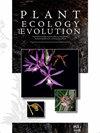为什么不同食草动物的适应性影响可以非加性地结合在一起,为什么它对植物-食草动物群落的生态学和进化很重要
IF 1.1
4区 生物学
Q3 PLANT SCIENCES
引用次数: 1
摘要
背景和目的-多种拮抗剂的作用如何结合是生态学中的一个基本问题。这个问题在植物-食草动物进化生态学中尤为重要,特别是预测多种食草动物对共同寄主植物的综合适应性影响是否可以通过简单地增加每个食草动物单独进食时的个体影响来推断。尽管积累了大量的经验数据,但在解释为什么食草动物损害的影响通常是非加性的组合,以及预测导致大于加性(协同)或小于加性(次加性)模式的条件方面,理论进展相对较少。材料和方法-基于有限资源和源汇关系的考虑,我提出并检验了两个假设:1)影响同一资源(即以相似方式摄食同一组织)的两种食草动物的适合度影响将以协同模式组合(如果该资源在植物不经历草食时不限制繁殖);2)影响不同资源(即摄食不同组织)的两种食草动物的适合度影响将以亚加性模式组合。我对马蹄铁(Solanum carolinense)进行了一项田间试验,将其暴露于四个水平的叶片草食和五个水平的模拟花草食的析因组合中。关键结果-结果与两种假设一致:1)模拟两种食花物种取食同一株植物造成的花损伤的综合适应度影响大于模拟两种食花物种单独取食时相同伤害总量的总和;(2)叶片和花的综合适合度影响小于两种单独取食时相同伤害总量的总和。结论:这些结果的主要生态进化含义是,以叶和花为食的食草动物的亚加性影响可能会削弱马蹄莲(或任何寄主多种食草动物的植物物种)的抗性选择,因此亚加性影响可能有助于维持共享一种寄主植物的多种食草动物群落。本文章由计算机程序翻译,如有差异,请以英文原文为准。
Why fitness impacts of different herbivores may combine nonadditively, and why it matters to the ecology and evolution of plant-herbivore communities
Background and aims – The manner by which the effects of multiple antagonists combine is a fundamental issue in ecology. This issue has been especially important in plant-herbivore evolutionary ecology—particularly predicting whether the combined fitness impacts of multiple herbivores on a shared host plant can be inferred by simply adding the individual impacts that each herbivore has when feeding alone. Despite accumulating empirical data, relatively little theoretical progress has been made in explaining why impacts of herbivore damage often combine nonadditively, as well as predicting the conditions that lead to a greater-than-additive (synergistic) or to a less-than-additive (subadditive) pattern.
Material and methods – Based on considerations of limiting resources and source-sink relationships, I proposed and tested two hypotheses: 1) The fitness impacts of two species of herbivores that affect the same resource (i.e. feed on the same tissue in a similar fashion) will combine in a synergistic pattern (if that resource is not limiting reproduction when plants do not experience herbivory), and 2) The fitness impacts of two herbivores that affect different resources (i.e. feed on different tissues) will combine in a subadditive pattern. I performed a field experiment in which horsenettle (Solanum carolinense) was exposed to a factorial combination of four levels of leaf herbivory and five levels of simulated floral herbivory.
Key results – The results were consistent with both hypotheses: 1) The combined fitness impact of flower damage that was simulated as being caused by two florivorous species feeding on the same plants was greater than the sum of the same total amount of damage when the two species were simulated as feeding individually; and 2) The combined fitness impact of the leaf and floral damage was less than the sum of the same total amount of damage when the two species fed individually.
Conclusions – The main ecoevolutionary implication of these results is that subadditive impacts of leaf- and flower-feeding herbivores could weaken selection for resistance in horsenettle (or any plant species that hosts multiple herbivores), and thus subadditive impacts may contribute to the maintenance of diverse herbivore communities sharing a species of host plant.
求助全文
通过发布文献求助,成功后即可免费获取论文全文。
去求助
来源期刊

Plant Ecology and Evolution
PLANT SCIENCES-
CiteScore
2.20
自引率
9.10%
发文量
27
审稿时长
>12 weeks
期刊介绍:
Plant Ecology and Evolution is an international peer-reviewed journal devoted to ecology, phylogenetics and systematics of all ‘plant’ groups in the traditional sense (including algae, cyanobacteria, fungi, myxomycetes), also covering related fields.
The journal is published by Meise Botanic Garden and the Royal Botanical Society of Belgium.
 求助内容:
求助内容: 应助结果提醒方式:
应助结果提醒方式:


